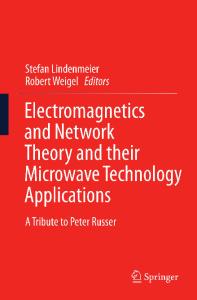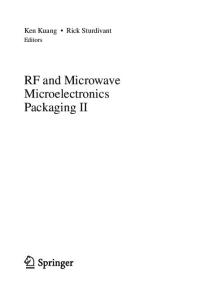Integrated (Ba,Sr)TiO3 Thin-Film Technology for RF and Microwave Applications
- PDF / 1,764,981 Bytes
- 12 Pages / 612 x 792 pts (letter) Page_size
- 27 Downloads / 270 Views
1075-J02-02
Integrated (Ba,Sr)TiO3 Thin-Film Technology for RF and Microwave Applications Toshimasa Suzuki, Daiki Ishii, Yoshiki Iwazaki, Kentaro Morito, and Youichi Mizuno Materials R&D div., Taiyo Yuden Co., Ltd., 5607-2 Nakamuroda, Takasaki, Gunma, 370-3347, Japan ABSTRACT The microwave tunable capability and its related material optimization of (Ba,Sr)TiO3 thin films in the parallel-plate capacitor form is discussed in terms of the dependence of barium concentration, acceptor doping, and in-plane film stress, based on the present broadband microwave characterization technique under various bias fields. The barium-content dependence indicates the tradeoff between tunability and dielectric loss, and the notable field-induced loss in SrTiO3 is confirmed as an intrinsic quasi-Debye contribution. The Mg dopant incorporated into a perovskite lattice shows almost no effectiveness on tunable device performance, except for enhanced insulation as an electron acceptor, while the low bias-field dependence of the dielectric loss suggests the possibility of the partial occupation of the alkaline-earth-ion site by Mg. The reduction of in-plane thermal stress controlled by the pressure during sputtering deposition leads to higher permittivity and tunability while degrading the film crystallinity by ion bombardment. The low-frequency loss tends to increase with crystal damage; however, the microwave loss remains unchanged, revealing the applicability of sputtering stress control to real microwave devices. In addition, we demonstrate the operation of an analog phase shifter using parallel-plate ferroelectric tunable capacitors and its application to a phased array antenna monolithically integrated on a silicon substrate.
INTRODUCTION The enormous growth in the market of wireless applications for consumers has led to the progressive reduction in the mass and volume of the wireless devices, particularly for hand-held communication systems, while improving their performance, reducing cost, and adding functionality [1]. Recently, low-temperature co-fired ceramics [2] and buildup organic-substrate technologies [3] that are capable of incorporating buried and surface-layer integrated passives and using few solder joints, have been considered as good prospects for the fabrication of downsized low-cost RF modules for wireless applications. Further, the use of monolithically integrated passives employing thin-film built-up technology enables a significant reduction in their size and weight and leads to their enhanced performance (Fig. 1) [4]. A decoupling capacitor for a stable, noise-free power distribution is the most suitable component for integrated passives as it replaces several discrete capacitors, eliminates solder joints, and reduces pin counts and parasitic inductance. In particular, high-dielectric thin films such as (Ba,Sr)TiO3 (BST) offer a very high capacitance density, enabling a substantial shrinkage of the total size. Furthermore, the voltage-controlled dielectric tuning of high-dielectric thin films can enhance the fun
Data Loading...










